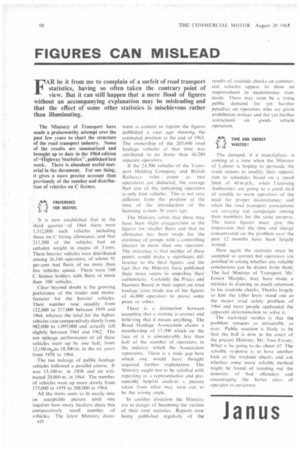FIGURES CAN MISLEAD
Page 62

If you've noticed an error in this article please click here to report it so we can fix it.
FAR be it from me to complain of a surfeit of road transport statistics, having so often taken the contrary point of
view. But it can still happen that a mere flood of figures without an accompanying explanation may be misleading and that the effect of some other statistics is mischievous rather than illuminating.
The Ministry of Transport have made a praiseworthy attempt over the pas( few years to chart the structure of the road transport industry. Some of the results are summarized and brought up to date in the 1964 edition of "Highway Statistics", published last week. There is abundant useful material in the document. For one thing, it gives a more precise account than previously of the number and distribution of vehicles on C licence.
It is now established that in the third quarter of 1964 there were 1,312,000 such vehicles including those on C hiring allowance, and that 217,300 of the vehicles had an unladen weight in excess .of .3 tons. These heavier vehicles were distributed among 56.340 operators. of whom 91 per cent had fleets of no more than live vehicles apiece. There were '160 C licence holder's With fleets of moti than 100 vehicles.'
Clear beyond doubt is the growing preference of the trader and manufacturer for the heavier vehicles. Their number rose steadily from 122,000 to 217,000 between 1959 and 1964, whereas the total for the lighter vehicles rose comparatively slowly from 982,000 to 1.095,000 and actually fell slightly between 1961 and 1962. The ton mileage performance of all these vehicles went up by one half, from 12,100 mto 18,500m. in the six years from 1958 to 1964.
The ton mileage of public haulage vehicles followed a parallel course. It was 13,100m. in 1958 and an estimated 20,000m. in 1964. The number of vehicles went up more slowly from 175,000 in 1959 to 208,000 in 1964.
All the items seem to fit neatly into an acceptable picture until one inquires how many hauliers share this comparatively small number of vthieles. The latest Ministry docu n.28
rnent is content. to reprint the figures published .a year ago showing the estimated position at the end of 1963. The, ownership of the .205.600 road haulage vehicles at that time . was -attributed to no _fewer than 46.280 separate operators.
If the 24.500 vehicles Of the Transport Holding Company and British Railways (who count as two operators( are deducted, the average fleet size of the 'remaining operators is only four vehicles.This is not very different from the position at the time of the introduction of the licensing system 30 Years ago.
The Ministry admit that there may have been slight exaggeration in the figures for smaller fleets and that, no allowance has been made for the existence of groups with a controlling interest in more than one operator. The inference is that neither of these point's isould make a significant difference to the final figures. and the fact that the Ministry have published them twice • seetns L..) underline' their
-. •
atithentieii.■, Certain's.' the Prices and Incomes Board in their report on road haulage rates made use of the figures of 46.000 operators to prove • some point or other.
There is a distinction between accepting that a statistic is correct and believing that it means anything. The Road Haulage Association claims a membership of 17.500 which on the face of it is considerably less than half of the number of operators in the industry which the Association represents. There is a wide gap here which one would have thought required further explanation. The Ministry ought not to be satisfied with repeating as a representative and presumably helpful analysis a picture taken from what may turn out to he the wrong angle.
in another direction the Ministry are in danger of becoming the victims of their own statistics. Reports now being published • regularly of the
results of roadside cheeks on commercial vehicles appear to show no improvement in maintenance standards. There ma v soon be a rising public demand for yet harsher penalties on operators who are given prohibition notices and for yet further
restriction i% on goods vehicle Operation.
CTIME AND ENERGY WASTED?
The demand if it materializes. is coming at a time when the Minister of Labour is hoping to' persuade. the . trade unions to modify their opposition 'to schedules based. on a 'speed limit of 40 m.p.h.; when Licensing Authorities are going to a good_ deal of trouble to warn operators of the need for proper maintenance; and when the road transport association are carrying out campaigns among their members for the same purpose. The latest figures must give the impression that the time and _energy concentrated on the problem over the past 12 months have been largely wasted. .
Here again the statistics must be accepted as correct but operators are justified in asking Whether any reliable conclusions can be drawn from them. The last Minister of Transport. Mr. Ernest Marples, may. have 'Made a mistake in drawing so. much .attention to his roadside cheeks. Thanks largely to him the kilter lorry stood' out as the major road safety problem of 1964 and most people applauded the apparent determination to solve it The statistical verdict is that the problem remains as intractable as ever. Public reaction is likely to he that the ball is now in the court of the present Minister. Mr. Tom Fraser. What is he going to do about it? The sensible response is to have another look at the roadside checks and ask whether some more reliable method might be found of weeding out the minority of bad offenders and encouraging the better class of operator to persevere.




















































































































